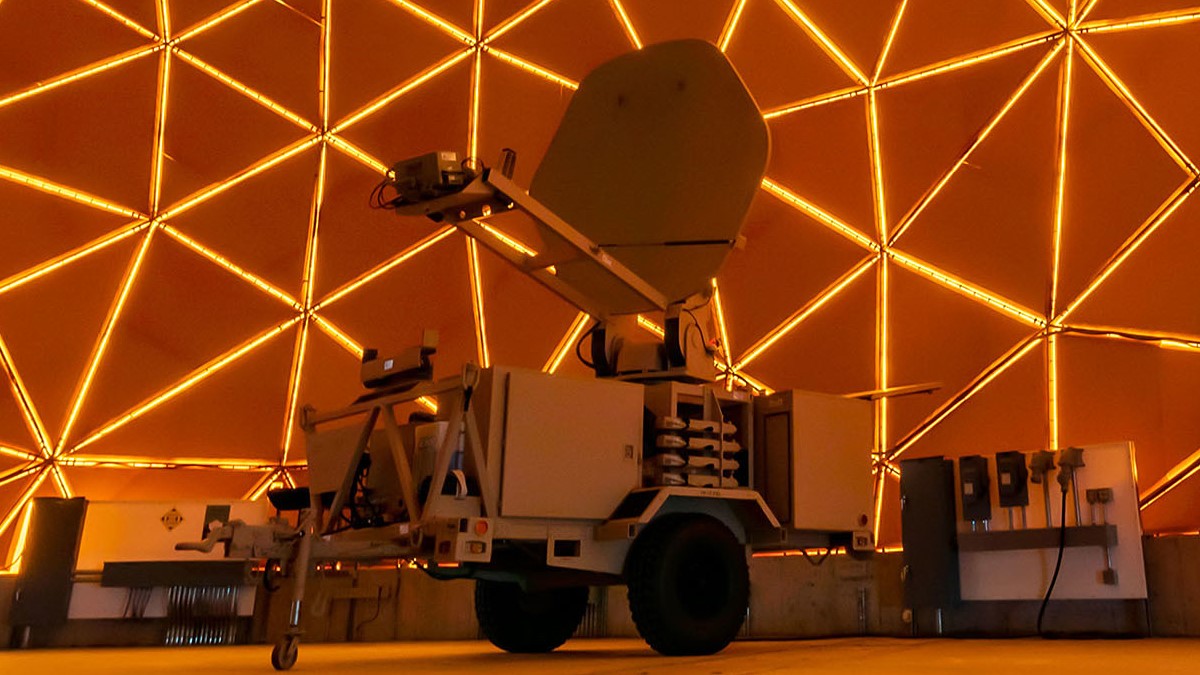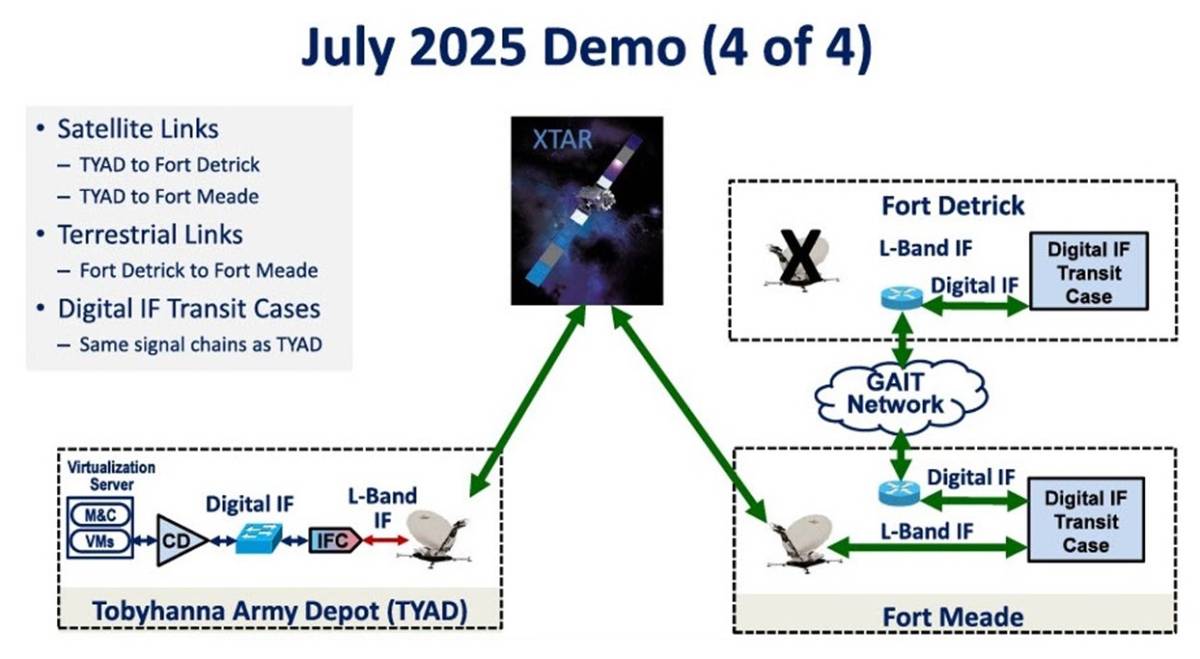 The radome at Tobyhanna Army Depot is used to test AN/TSC-167 Satellite Transportable Terminals (STT), replacing the temporary structures in use now. (Credit: U.S. Army photo by Thomas Robbins, Tobyhanna Army Depot (via DVIDS). The appearance of U.S. Department of Defense visual information does not imply or constitute DoD endorsement.)
The radome at Tobyhanna Army Depot is used to test AN/TSC-167 Satellite Transportable Terminals (STT), replacing the temporary structures in use now. (Credit: U.S. Army photo by Thomas Robbins, Tobyhanna Army Depot (via DVIDS). The appearance of U.S. Department of Defense visual information does not imply or constitute DoD endorsement.)
Not every defense technology is kinetic. Some of the most lethal systems are the ones that enable the kill chain, giving warfighters the ability to observe, orient, decide and act to achieve an objective faster and more effectively than an adversary. For the U.S. Department of War, that capability is inextricably linked to its global satellite communications network.
In the 2020 book The Kill Chain: Defending America in the Future of High-Tech Warfare, Christian Brose warns that the U.S. has focused too much on large, exquisite platforms that don’t speak the same language, rather than the speed and efficacy of its kill chains. The result, Brose writes, is “a U.S. military version of the Tower of Babel.”
Today’s milsatcom networks are characterized by stove-piped hardware systems that can’t communicate with one another. A recent successful demonstration of digital intermediate frequency (Digital IF or DIFI) technology marked a promising start to breaking down that Tower of Babel.
Decoupling RF Conversion and Signal Processing
Much of the problem of interoperability begins with satellite teleports and terminals. Milsatcom users are often burdened with purpose-built boxes that keep them physically cabled to a specific site, beholden to a specific vendor and unable to move data dynamically across assets.
“This is the core of the problem the Department of War is trying to solve,” said Juan Deaton, chief alignment officer at Alignment Consulting and Engineering and executive director of the WAVE Consortium. “It’s complicated to unravel, but DIFI is the first step.”
In a traditional satcom system, the modem is often a limiting factor, serving two basic functions: IF conversion and digital signal processing. Both functions are typically integrated in a proprietary box that transmits and receives an analog intermediate frequency, like L-band.
Digital IF decouples those two functions. An IF converter placed at or near the antenna transforms analog IF signals into digital IF streams and vice-versa. When the signal is converted to zeros and ones, it is packetized, or put in a standard format, making it compatible with any network that handles IP traffic.
Rather than an analog signal that degrades over the length of a coaxial cable, digital IF streams can be transported virtually anywhere accessible by an IP network, then processed by software-defined modems and other virtual machines running on local general-purpose compute or the cloud.
This enabling technology is critical to the digital transformation of the U.S. military’s satellite ground infrastructure. The 2026 defense budget sets aside $70 million to deploy digital IF installations at DoW teleports worldwide. A draft request for information, scheduled for release after the government shutdown, calls for flexible, standards based Digital IF architecture to be installed in up to 18 sites globally, with the goal of fielding capabilities by 2028.
As the top user of milsatcom, the U.S. Army is leading this effort through the Defense Enterprise Wideband Satellite Communications Systems (DEWSS), a program of record for DoW-wide strategic communications, led by Product Manager, Wideband Enterprise Satellite Systems (PdM WESS).
Seamless Failover: A Digital IF Demonstration
In July, PdM WESS put Digital IF to the test with a three-site antenna failover demonstration using equipment from two different vendors. (See related story here.)
The demo used one XTAR satellite with a link originating at the Tobyhanna Army Depot in Pennsylvania and received at Fort Detrick, Maryland. The team “pulled the plug” on the Fort Detrick antenna, triggering an automatic failover to another antenna at Fort Meade, Maryland, more than 50 km away.
“It failed over, restoring the link, without skipping a beat,” said Dr. AJ Vigil, senior scientist at Systems Technologies Inc. and digital IF technical lead for PdM WESS during a MILCOM 2025 workshop on the digital transformation of satcom.
 Image shows the successful multi-site antenna failover demonstration led by PdM WESS in July 2025. (Credit: Systems Technologies, Inc.)
Image shows the successful multi-site antenna failover demonstration led by PdM WESS in July 2025. (Credit: Systems Technologies, Inc.)
The Digital IF used in the demonstration conformed to the DIFI (Digital IF Interoperability) protocol. Rather than losing the signal when Fort Detrick was taken offline, the Digital IF streams were rerouted through the Global Agile Integrated Transport (GAIT) network, the global Wide Area Network (WAN) connecting the Army’s Regional Hub Nodes and DoD gateways using various routing paths to ensure continuous high-capacity data exchange in contested or degraded environments.
The gateway at Fort Meade picked up the Digital IF stream through the GAIT and completed the signal chain with a terminal on-site, successfully closing the link. Quintech Electronics developed the control architecture and digital IF transport to automatically reroute Digital IF streams via terrestrial WAN when the satellite link was disrupted.
Why It Matters
The three-site failover was a first-of-its-kind demonstration for a DoW audience. It showed how a satcom network can be secured against a single point of failure. By separating conversion and signal processing from a proprietary modem, it showed that signal processing can be done almost anywhere with an IP connection and sufficient power and bandwidth to run software-defined modems. It proved to military operators that automatic failover is possible; they don’t have to accept seconds or minutes of outages due to manual switching.
“We turned skeptics into believers,” Vigil said. “Because there’s nothing like pulling the plug on an antenna and seeing the link restored before you blink your eye.”
Demonstrated by PdM WESS in July 2025:
- Complete Digital IF signal chains
- Digital IF Modem (DM) through IF converter (IFC)
- Multiple Digital IF carriers
- Digital IF signal chains from two different vendors
- Modem virtualization
- A true 3-site demonstration
- Digital IF transport over DoD WAN (GAIT)
- Automated failover between antennas at different sites
- All demonstrations conducted by Army operators in uniform
Another key element of the PdM WESS demo was successfully processing multiple carriers over wideband satcom feeds. This is central to supporting existing milsatcom networks and a testament to the success of DIFI standardization.
The Roadmap and Low-Hanging Fruit
Despite the success of the demo, Digital IF has its limitations. DIFI streams can require significant bandwidth (10+ Gbps networks) to achieve the very high sampling rate needed to accurately capture the RF signal. Similarly, digital to analog converters and analog to digital converters require high-performing electronic circuits, like FPGAs and the transition from analog to digital equipment can be costly. Additionally, work continues through the Digital IF Interoperability (DIFI) Consortium to shore up standards and protocol for DIFI packets, addressing issues like time synchronization and jitter.
Getting to the point where an RF signal can be transmitted as IP packets and reliably read by virtual machines on the other side has been a feat. Despite this milestone, it is still just the beginning.
Simon Swift, engineering director at ETL Systems, compared the DIFI roadmap to the evolution of standards and technologies in the mobile industry, through organizations like 3GPP.
“If you have tried to bring a new technology forward, you don’t go for the big bang at the end,” Swift said at MILCOM 2025. “The only successful integrations I’ve ever watched have gone in baby steps. And this is exactly what we’re trying to do here.”
Digital IF has proven effective in satcom systems using Frequency Division Multiple Access (FDMA), a simpler multi-carrier technique that divides the total available bandwidth of a link into single, non-overlapping channels for each user. But FDMA has limitations, especially when adding more users. That has raised questions about applying Digital IF to more complex channeling schemes, like Multi-Frequency Time Division Multiple Access (MF-TDMA) and Frequency Hopping Spread Spectrum (FHSS).
According to a DIFI roadmap set out by PdM WESS, FDMA missions represent the “low-hanging fruit.” Deploying Digital IF in these missions will be an immediate priority backed by new DoD funding.
The next big step: getting Digital IF certified for the Wideband Global Satcom (WGS) system. WGS is the high-capacity satcom backbone for the U.S. military and its allies, that also supports FDMA missions.
“If you can operate over WGS, you can operate over any GEO satellite,” Vigil said. “That’s where your toughest performance challenge is.”
Migrating WGS operations to Digital IF in the ground segment will require changes in performance requirements and certification, which do not currently support a digital paradigm.
For Want of a Nail …
As with any technology transformation, the shift to digital satcom will not happen overnight. Advancing Digital IF is a game of inches for capabilities that promise to deliver in miles.
“Technology requires attention to make it happen,” said Vigil, who pointed to a 2028 timeframe for fielding the DoW’s first Digital IF teleports. “It’s not just about building, it’s about giving technology the attention it requires.”
Digital IF is beginning to receive greater attention. But proponents still find it challenging to communicate the outsized impact of an enabling technology or niche standard to large, risk-averse organizations.
Recent conflicts have demonstrated that there is no substitute for reliable, resilient satcom to effectively close kill chains and deny adversaries’ power projection. What may seem like an inconsequential change from existing systems could be the difference between a signal failing over or failing. As the saying goes, for want of a nail, the kingdom was lost.
Explore More:
Podcast: SD-WAN, Multi-Orbit Access and a New Age for Satcom
Breaking Down the Argument for RF over Fiber
Pioneering Resilience: PdM WESS and the Digital IF Revolution
